Introduction
Comme ville intelligente construction deepens, can we imagine a city without LED displays?
From traffic guidance to public information dissemination, Afficheurs LED are no longer simple advertising tools, but rather an important component of urban management and services.
So, how exactly do LED displays help smart cities operate more efficiently? What conveniences can they bring to citizens?
Table des matières
1. Application Scenarios of LED Displays in Smart Cities
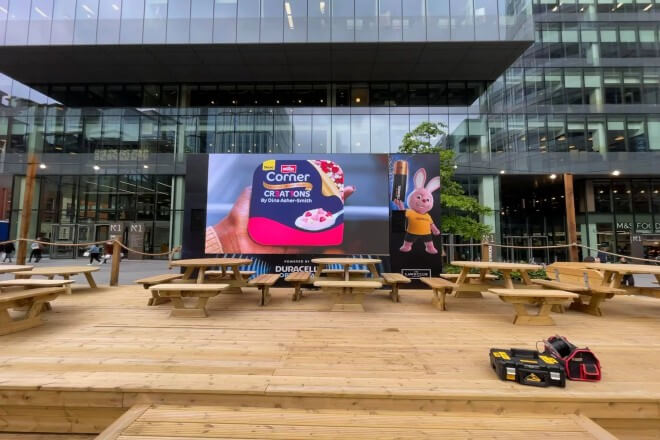
1) Public Information Dissemination
Have you ever seen real-time traffic information or weather warnings displayed on LED screens while waiting for a bus or subway?
This information not only helps you understand road conditions in a timely manner but also allows you to plan your travel routes and avoid unnecessary trouble.
For example, in city transportation hubs or squares, LED screens can quickly display “Road ahead is congested, detour recommended” or “Heavy rain is expected tomorrow, please bring rain gear.”
In case of emergencies, such as sudden accidents or temporary road closures, LED screens will also immediately issue alerts, ensuring that citizens can understand important information in advance and avoid inconvenience caused by information delays.
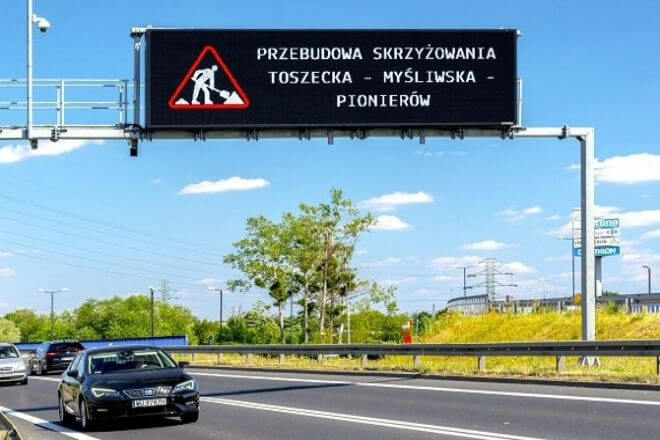
2) Intelligent Traffic Management
Traffic congestion is a persistent problem in large cities, especially during peak hours, making traffic management crucial.
LED displays play a key role here, helping drivers choose routes more intelligently based on real-time traffic data.
For example, when a traffic jam occurs on a road, an LED screen will immediately alert drivers: “Traffic accident on XX section, please detour,” or “Current road is clear, estimated arrival time at destination is within 15 minutes.”
This not only reduces traffic congestion but also saves drivers time and effort by avoiding unnecessary detours.
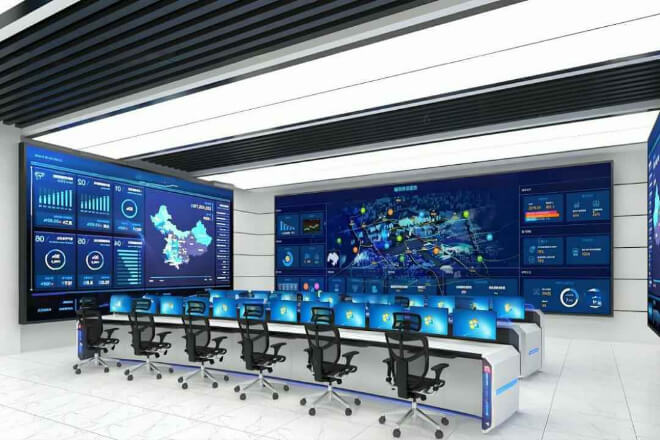
3) Environmental Monitoring and Data Display
Dans villes intelligentes, environmental monitoring is no longer a behind-the-scenes task.
You’ll find LED displays throughout the city displaying not only traffic information but also real-time data such as air quality, temperature, and humidity.
These screens act like health “monitors” for the city, reminding everyone to pay attention to their surroundings.
For example, when air quality deteriorates, an LED screen might display: “PM2.5 levels exceed standards, please take precautions.”
Or, it could display “Current temperature: 35°C, humidity: 90%”, helping citizens better plan their daily activities and even reminding them to “wear masks when going out”.
This real-time display of information not only allows citizens to understand their surroundings at any time but also enables them to make more appropriate choices when the weather is not good.
2. How do LED displays improve urban management and service efficiency?

LED displays not only improve the speed at which we obtain information but also make urban management more intelligent and efficient.
So, how exactly do LED displays contribute to urban management? Let’s take a look!
1) Real-time data transmission and visualization
A city operates like a complex machine, where each component needs precise coordination.
A crucial role of LED displays is to display real-time data, allowing managers to clearly see the city’s “health status”.
For example, traffic data, air quality, and weather changes can all be updated in real time through LED displays, allowing government departments to quickly grasp the situation and make timely adjustments.
For instance, when traffic flow on a main road suddenly surges, the LED screen will immediately display “Traffic busy, detour recommended,” helping citizens avoid congested areas.
This is like a city’s “health monitor,” allowing every detail to be observed in real time, thus preventing problems from escalating.
2) Intelligent Emergency Response
Whether it’s a sudden natural disaster or a traffic accident, LED displays can always promptly convey the most important safety information to citizens.
In a city’s emergency response system, LED screens act like “city broadcasters,” quickly issuing warnings at critical moments.
For example, before a rainstorm, LED screens will display “Rainstorm Warning, Drive Safely,” and if an emergency occurs, they will immediately issue important reminders such as “Traffic Accident, Avoid Driving on XX Section,” helping everyone react promptly.
Moreover, LED displays can update this information instantly, maintaining their timeliness and ensuring citizens receive the latest safety alerts.
Whether it’s sunny or rainy, LED screens can provide immediate assistance, avoiding chaos caused by information delays.
3. LED Displays' Role in Smart City Marketing and Brand Building
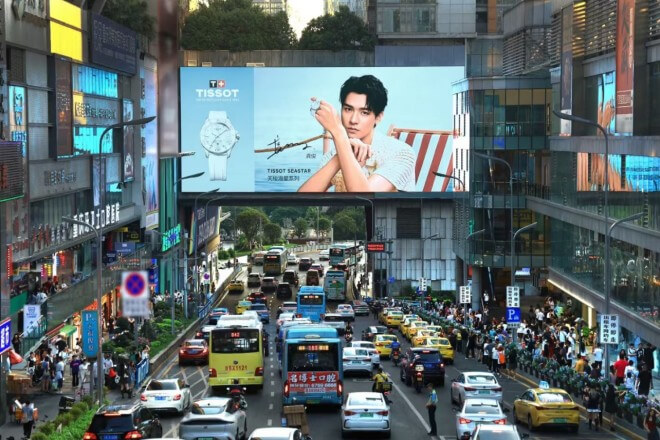
The application of LED displays in urban public areas is undoubtedly a “golden battleground” for brand promotion.
Whether in bustling squares, busy centres commerciaux, or transportation hubs, LED billboards attract passersby’s attention with their large display area and dynamic content.
Compared to traditional static advertising, the dynamic visuals and varied display methods of LED screens are more effective at capturing the attention of passersby.
For example, a restaurant brand can play enticing food videos or launch dynamic advertisements for limited-time offers on an LED display screen, generating an immediate desire to purchase among passing customers.
Through such advertising displays, brand exposure can be significantly increased, attracting not only pedestrians but also drivers, thereby enhancing brand awareness.
Furthermore, LED screens can be adjusted in real time according to time, season, or event, ensuring the relevance and timeliness of advertising content.
For example, during holidays, LED screens can display advertisements for promotional activities or limited-edition holiday products, precisely capturing consumers’ attention.
Smart retail is a new shopping experience that has become popular in recent years. It combines big data, artificial intelligence.
And other technologies to drive the digital transformation of the retail industry. LED displays are one of the core tools in this transformation.
Retailers can leverage LED screens to display product information, promotions, and limited-time discounts, while interactive features enhance customer engagement and the shopping experience.
For example, in a large shopping mall, LED displays can show real-time product features, prices, and inventory information, or play customer review videos to attract shoppers.
LED screens combined with smart technology can deliver personalized advertising based on consumer behavior, preferences, or location.
For instance, when a customer approaches a particular counter, the LED screen can automatically display promotional information or new product recommendations for that area, helping merchants target their marketing more precisely and stimulating consumer purchasing desires.
Furthermore, LED displays can integrate with online platforms, using QR codes and mobile payment to further enhance the consumer experience and conversion rates.
Imagine customers scanning a QR code on a dynamic advertisement to make online payments or participate in promotional activities, significantly improving convenience.
4. Innovative Applications of LED Displays in Smart City Public Facilities
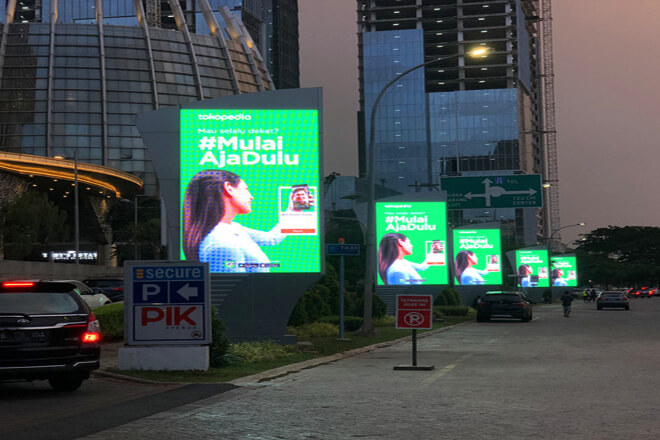
LED displays have brought many innovative application scenarios to public facilities, improving the quality of life for citizens and the operational efficiency of cities.
Next, let’s look at how these innovative applications are changing our daily lives.
1) Smart Parking and Wayfinding Systems
The difficulty of finding parking in cities has long plagued many citizens, especially in commercial areas and high-traffic areas.
By integrating with smart parking systems, LED displays can show citizens the number of available parking spaces in real time, helping drivers quickly find a parking spot.
You no longer need to wander around parking lots looking for a space; the LED screen directly displays “XX parking lot has 20 available spaces,” saving time and increasing efficiency.
Furthermore, LED displays are widely used in urban wayfinding systems. For example, in large shopping malls, transportation hubs.
Or parks, LED screens can display the shortest walking routes or guidance information for different floors, helping citizens quickly find their destinations.
No more getting lost in vast parking lots or busy streets; the real-time navigation system provided by LED displays makes city exploration much simpler.
2) Interactive Information Systems
With the development of technology, many LED displays are no longer just static information publishing platforms.
They are beginning to integrate touch technology, becoming part of interactive information systems.
These smart LED screens can provide interactive query services based on citizens’ needs.
For example, citizens can use touchscreen LED displays to check traffic routes, real-time bus arrival information, and even get the latest news on city events.
Imagine at a subway or bus stop, citizens can use touchscreen LED displays to check the latest traffic conditions or view information on nearby restaurants, shops, and entertainment activities.
This real-time interactive service not only enhances the citizens’ travel experience but also makes various city services more flexible and personalized.
Through this interactive information system, LED displays not only help citizens solve practical problems but also strengthen the interaction between people and the city, making information access more intuitive and convenient.
5. How to Choose a Suitable LED Display Solution?
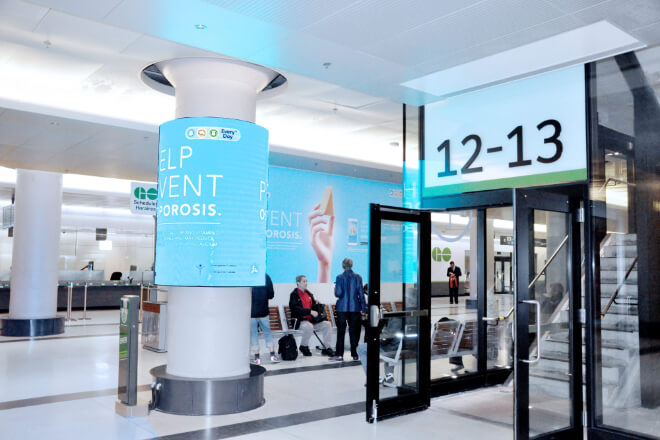
1) Screen Type and Configuration Selection
In smart cities, the variety of LED displays is dazzling. Different application scenarios have different requirements for LED displays, so choosing the right screen type is crucial.
If you want your advertising or information display to be “cool without obstructing the view,” a transparent LED screen is a good choice.
It can display advertising content while maintaining the transparency of the building’s exterior, making it suitable for the exterior decoration of shopping malls, glass curtain walls, or modern buildings.
- Outdoor Large DIRIGÉ Screens:
Outdoor LED advertising screens are the most common choice for plazas, transportation hubs, or busy city streets.
They are not only large but can also display various dynamic content, attracting attention.
Under strong sunlight, high-definition large screens can clearly display advertisements and information, ensuring that every passerby can see them.
If you need high resolution to display detailed images and videos (such as in city monitoring centers or exhibition halls), small-pitch LED screens can provide higher quality images, showcasing every detail vividly.
Choosing the right display type requires first clarifying what content you want to display, where you want to display it, and your budget.
This ensures that the LED display can maximize its ability to meet your needs and achieve the best results.
2) Design and Installation Considerations
When installing LED displays, considering the special characteristics of the urban environment, we also need to pay attention to some details to ensure the long-term stable operation of the LED screen.
- Waterproof and Dustproof:
LED screens are exposed to wind, sun, and rain in urban environments, making waterproof and dustproof protection crucial.
Choosing screens with an IP65 or higher protection rating ensures they can withstand rain and dust, allowing for stable operation over extended periods.
- Luminosité and Glare Resistance Design:
Urban lighting environments vary greatly, from intense sunlight during the day to dim lighting at night.
The brightness and glare resistance design of LED displays must adapt to these changes, ensuring clear visibility both day and night.
For example, a high-brightness LED screen can display clear advertisements in sunlight, while automatically adjusting brightness at night for a clear, non-glaring display.
- Distance de visualisation and Size:
The size of an LED display is closely related to the viewing distance. Larger venues like highways or plazas require larger screens to ensure visibility for distant viewers.
While in smaller displays, the screen size and resolution must be suitable for the viewer’s distance to avoid waste.
- Easy Installation and Maintenance:
Urban environments are often complex, so LED display installation must consider structural safety and ease of maintenance.
Choosing a modular LED screen design allows for individual replacement of any faulty modules, reducing maintenance costs and time.
6. Conclusion
In summary, what important roles do LED displays play in the development of smart cities?
They not only make information transmission more immediate and accurate, but also improve urban management efficiency and the quality of life for citizens.
What innovative applications will they bring to smart cities in the future? Perhaps the answers to these questions await our discovery.
Finally, if you would like to learn more about LED displays, veuillez nous contacter.
